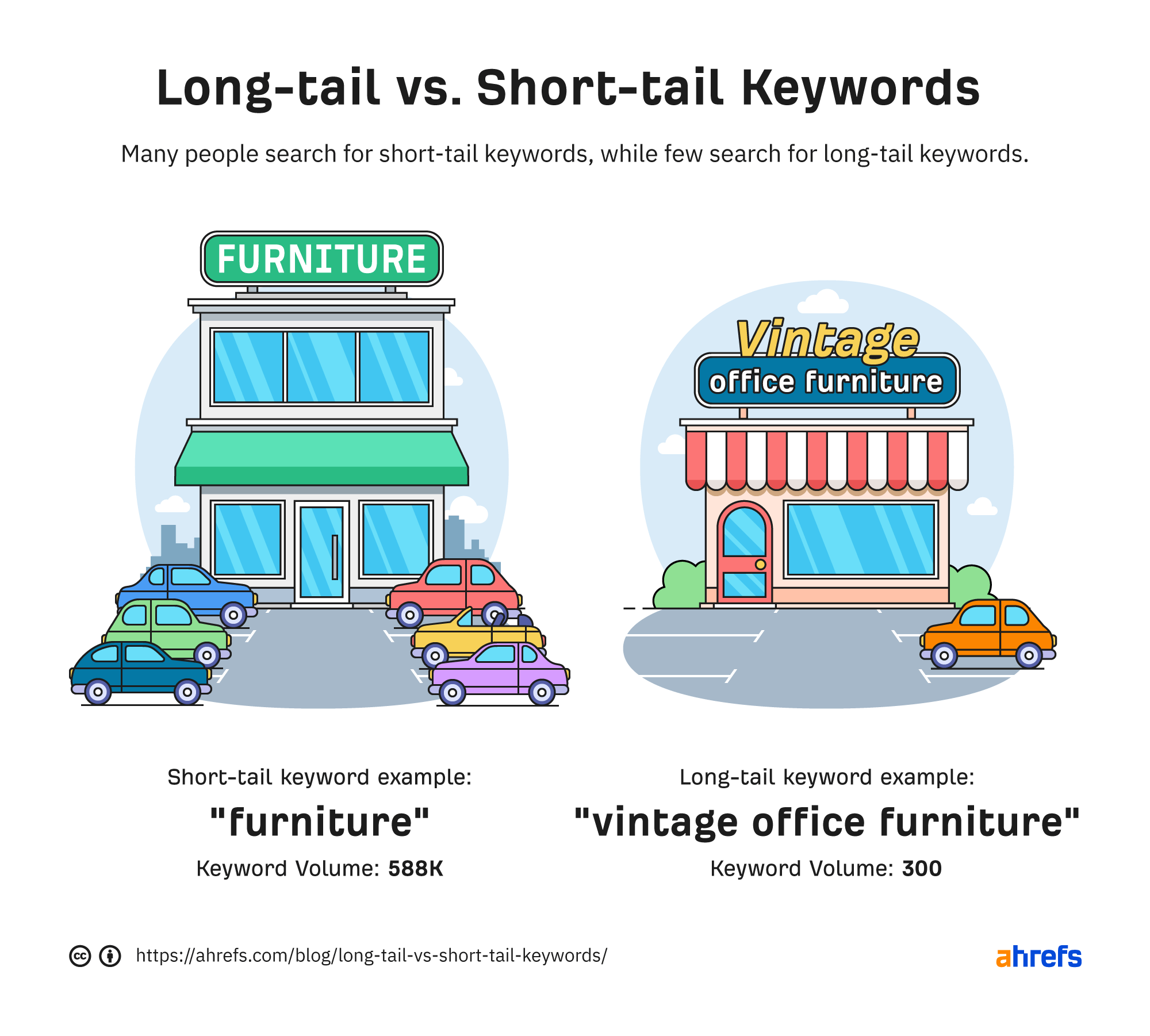Keywords are the bridge between your content and your audience. They’re the words and phrases people use to find information, products, or services online. However, not all keywords are equally valuable. There’s a spectrum, ranging from broad, high-traffic short-tail keywords to specific, niche long-tail keywords. Both keyword types have their merits and the key to success lies in finding the right balance for your business.
What Are Short-Tail Keywords?

Short-tail keywords are typically one or two words long and represent broad search terms with high search volume. Think “bags,” “marketing,” or “travel.” They’re the heavy hitters, attracting a large audience but also facing fierce competition.
Pros
- High search volume: Potential for massive reach and brand exposure.
- Top-of-the-funnel traffic: Attract early-stage users of their search journey, ideal for building awareness.
- Authority building: Ranking for competitive short-tail keywords positions your website as a leader in your industry.
Cons
- High competition: Difficult to rank for, especially for smaller or newer websites. You’ll be competing against established brands with deep pockets and extensive backlink profiles.
- Lower conversion rates: The broad nature of short-tail keywords means the traffic they attract is less targeted, leading to lower conversion rates.
- Varied intent: It’s challenging to pinpoint the user’s exact intent, making it harder to tailor content effectively.
Finding the Right Short-Tail Keywords
Unearthing the right short-tail keywords requires careful consideration and research.
- Brainstorming: Start with a list of core topics related to your business. Think about the products or services you offer, your industry, and your target audience’s pain points.
- Keyword Research Tools: Utilize tools like Google Keyword Planner, Ahrefs Keywords Explorer, or SEMrush to expand your list and analyze search volume and competition.
- Competitor Analysis: See what short-tail keywords your competitors are ranking for and consider if they align with your business goals.
Remember, relevance is crucial. Choose short-tail keywords that are directly related to your core offerings and avoid those that are too broad or unrelated to your niche.
What Are Long-Tail Keywords?

Long-tail keywords are longer, more specific phrases that often have lower search volume but much higher conversion potential. They’re the hidden gems, attracting a smaller but highly targeted audience that’s closer to taking action. Think “women’s running shoes for flat feet” or “best SEO strategies for small businesses.”
Pros
- Less competition: Easier to rank for, even for newer websites.
- Higher conversion rates: Attract users who are further along in the buying journey and more likely to convert.
- More targeted traffic: You’re attracting visitors who are genuinely interested in your specific offerings.
- Improved user experience: You can provide content that directly answers specific questions, enhancing the user experience.
Cons
- Lower search volume: Each long-tail keyword might have less traffic potential.
- Requires more content: You’ll need to create more content to target various long-tail keywords.
Uncovering Long-Tail Keyword Opportunities
Discovering those valuable long-tail keywords requires a bit of detective work:
- People Also Ask (PAA): Google’s “People Also Ask” section reveals many questions people are asking about a topic. These questions often make excellent long-tail keywords.
- Autocomplete Suggestions: Start typing a broad keyword into Google and observe the suggestions that appear. These can reveal popular long-tail variations people are actively searching for.
- Keyword Research Tools: Utilize tools like Google Keyword Planner, Ahrefs, or SEMrush to generate long-tail keyword ideas and analyze their search volume and competition.
- Customer Feedback and Reviews: Pay close attention to your customers’ language use when describing your products or services or asking questions. Their feedback can uncover hidden long-tail gems.
- Social Media Listening: Monitor conversations on social media platforms and forums to see what questions and topics your target audience is discussing.
Choosing Between Short-tail vs Long-tail Keywords

The key to successful keyword research is finding the right balance between short-tail vs long-tail keywords. It’s not an either/or situation; it’s about strategically incorporating both into your SEO strategy to target users at different stages of their journey.
- Short-tail keywords: Use them to build brand awareness, attract top-of-the-funnel traffic, and establish authority in your industry.
- Long-tail keywords: Use them to target specific niches, attract qualified leads, and drive conversions.
Think of it like a balanced diet. You need macronutrients (short-tail keywords for broad reach) and micronutrients (long-tail keywords for targeted impact) to thrive.
Implementing a Balanced Keyword Strategy
To effectively use both short-tail and long-tail keywords, consider these tips:
- Create a Keyword Map: Map out your target keywords and assign them to specific pages or content pieces on your website. This helps you avoid keyword cannibalization and ensures each page has a clear focus.
- Develop a Content Strategy: Create a mix of content that targets both short-tail and long-tail keywords. This could include blog posts, articles, product descriptions, landing pages, and more.
- Optimize for Search Intent: Ensure your content aligns with the user’s search intent, whether it’s informational, navigational, or transactional.
- Track Your Progress: Monitor your keyword rankings, organic traffic, and conversion rates to see how your strategy is performing. Adjust your approach as needed to achieve optimal results.
Conclusion
Short-tail and long-tail keywords are not rivals; they’re partners in the quest for SEO success. By understanding their unique strengths and weaknesses, you can create a balanced keyword strategy that attracts a wider audience, drives targeted traffic, and boosts your website’s authority.
So, don’t limit yourself to one or the other. Combine short-tail and long-tail keywords and watch your website climb the search rankings, one strategic step at a time.



